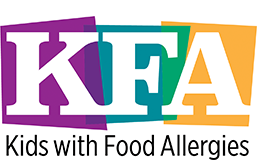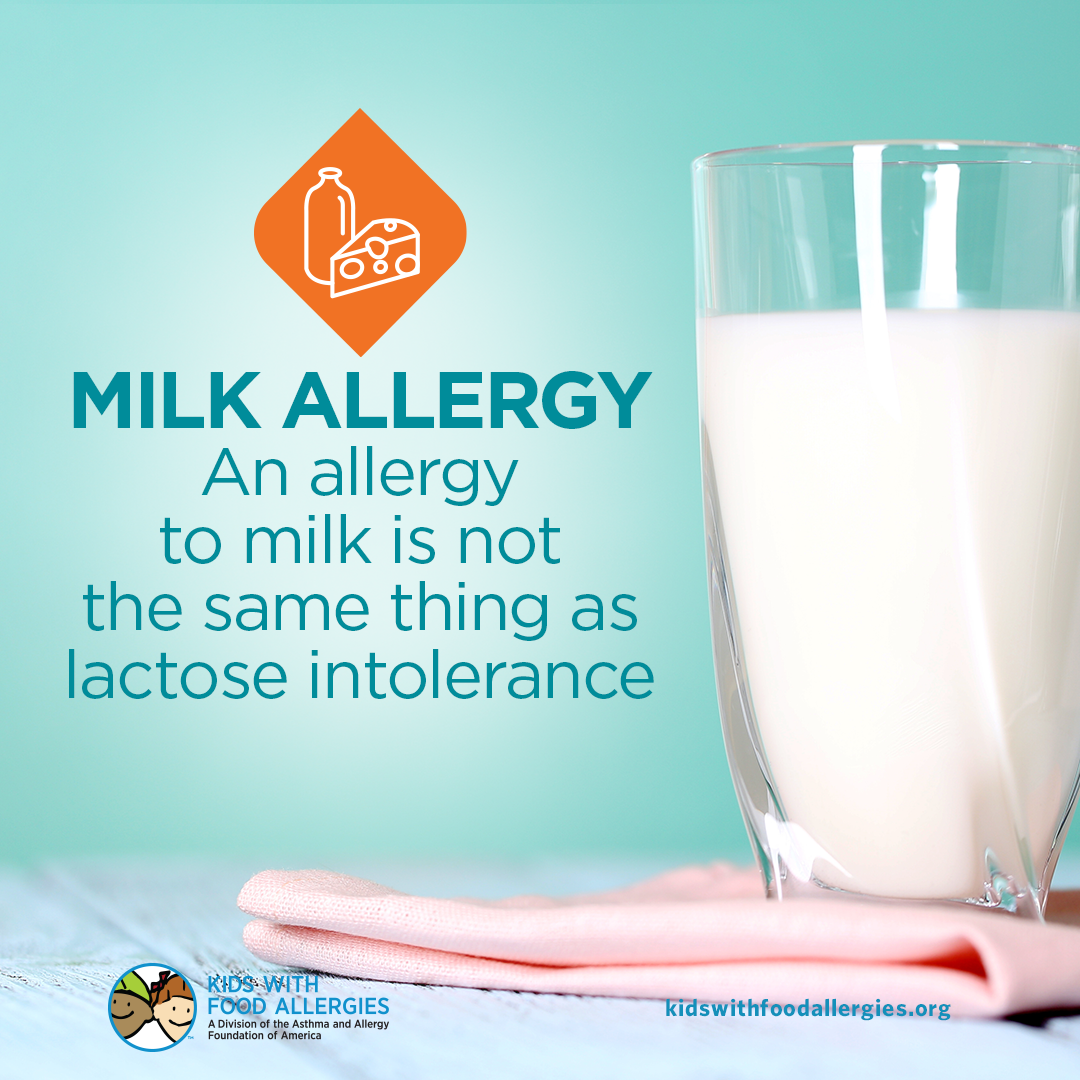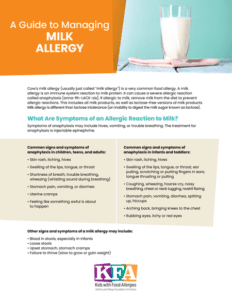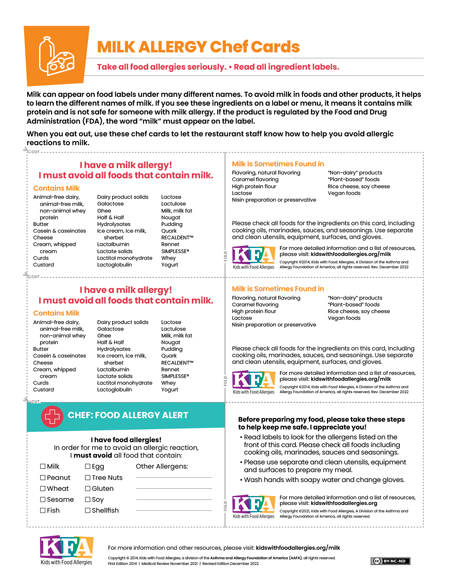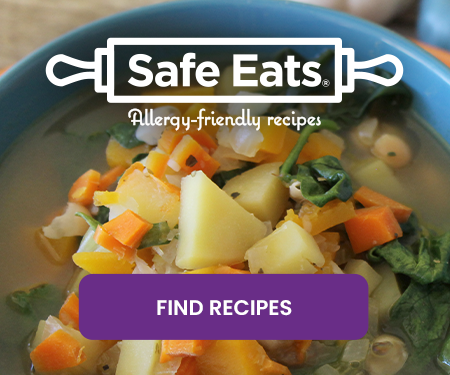Living with Food Allergies

Milk Allergy
Cow’s milk allergy (usually just called “milk allergy”) is a very common food allergy among children. About 1.9% of U.S. children have a milk allergy.1 It is also one of the most common food allergies worldwide.
A milk allergy is an immune system reaction to milk protein. Milk contains many different proteins, but casein and whey are the two groups of proteins most likely to be allergens. Milk allergy can be severe and life-threatening if not treated promptly. There is no cure for milk allergy. Milk allergy can impact a child’s growth and negatively impact their emotional and mental health as well.
It is possible to lead a healthy life without milk. You can successfully manage milk allergy with knowledge, support, and resources. This guide will help you manage milk allergy with confidence.
Closed
What are the symptoms of milk allergy?
There are two categories of milk allergy:
- IgE-mediated – Your immune system makes antibodies called immunoglobulin E (IgE) antibodies. These IgE antibodies react with a certain food, such as milk, and cause symptoms. This can cause a severe allergic reaction called anaphylaxis [anna-fih-LACK-sis].
- Non-IgE-mediated − Other parts of the body’s immune system react to milk in this type of reaction. This reaction causes symptoms too. But it does not involve an IgE antibody. Most of these symptoms affect your digestive tract.
You can have both IgE-mediated and non-IgE-mediated food allergies. Symptoms in both types of these immune responses may overlap.
When you have an IgE-mediated milk allergy, you need to be aware of the symptoms of anaphylaxis. Symptoms of anaphylaxis may include hives, vomiting, or trouble breathing. The treatment for anaphylaxis is injectable epinephrine.
Signs and symptoms of anaphylaxis include in children, teens, and adults include:
- Skin rash, itching, hives
- Swelling of the lips, tongue, or throat
- Shortness of breath, trouble breathing, wheezing
- Stomach pain, vomiting, diarrhea
- Feeling like something awful is about to happen
Common signs and symptoms of anaphylaxis in infants and toddlers include:2
- Skin rash, itching, hives
- Swelling of the lips, tongue, or throat
- Stomach pain, vomiting, diarrhea, spitting up
- Hiccups
- Arching back, bringing knees to the chest
- Coughing, wheezing
- Rubbing eyes, itchy or red eyes
Other signs and symptoms of milk allergy may include:
- Blood in stools, especially in infants
- Loose stools
- Upset stomach, stomach cramps
- Failure to thrive (slow to grow or gain weight)
How do doctors diagnose milk allergy?
Your doctor will examine you. They will ask you questions about your history. They will ask you what happens when you eat/drink foods with milk. If they suspect an IgE-mediated milk allergy, they may order allergy testing to help confirm the diagnosis. A skin prick test or a blood test known as a specific IgE test may be used by your doctor to diagnose this food allergy. Allergy testing is generally not helpful or suggested for non-IgE-mediated reactions.
Another test called an oral food challenge may be done by an allergist to diagnose a milk allergy or confirm if the allergy has been outgrown. There are other conditions that may be triggered by cow’s milk, so you may also receive a referral to a gastroenterologist (or “GI doctor”).
What is the difference between cow's milk allergy, dairy allergy, lactose intolerance, and cow's milk protein intolerance?
You may see these different terms: cow’s milk allergy (CMA), cow’s milk protein allergy (CMPA), dairy allergy. They all mean the same thing.
To keep it simple, KFA uses the term “milk allergy.”
A milk allergy is an IgE-mediated allergic reaction to milk protein. Milk allergy can be severe and life-threatening.
You may have also heard of milk intolerance using the terms: lactose intolerance and cow’s milk protein intolerance. These are different from a milk allergy.
Lactose intolerance is not caused by an immune response to milk. In lactose intolerance, your body can’t digest lactose (milk sugar) found in milk and milk products. Symptoms of lactose intolerance may include bloating, belly pain, and cramps. It is not life-threatening. Lactose intolerance doesn’t cause the immune system to react. The symptoms are typically limited to gastrointestinal (stomach or digestion) symptoms. People with lactose intolerance can eat milk products that have the lactose sugar removed, or they can take an enzyme (lactase) to help them digest lactose.
Food protein-induced allergic proctocolitis (FPIAP) – also called “cow’s milk protein intolerance (CMPI)” or “allergic proctocolitis” – is non-IgE-mediated allergy to cow’s milk proteins found formula or breast milk. This condition inflames the lower part of the intestine. It affects infants in their first year of life and they typically outgrow within the first few years of life. The symptoms include blood-streaked, watery and mucus-filled stools. Infants may also develop green stools, diarrhea, vomiting, anemia (low blood count) and fussiness.
How can I prevent milk allergy reactions?
Milk can be found in almost any type of food. Foods that contain milk include ice creams, frozen desserts, cakes, pies, cookies, cream sauces, pasta dishes, casseroles, mashed potatoes, meat that is breaded, and so much more.
The only way to avoid an allergic reaction is to remove milk from your diet. This includes all milk products, as well as lactose-free versions of milk products.
But you can successfully manage your milk allergy. This can be done by:
- Working with your doctor
- Reading labels
- Being aware of cross-contact (when foods come into contact with each other and may transfer an allergen into a food that shouldn’t have it)
- Clearly communicating with school staff, people who prepare your child’s food, and babysitters and other caregivers
How do I read labels for milk?
Under the Food Allergen Labeling and Consumer Protection Act (FALCPA), food companies must label their products clearly if they contain milk.
When reading labels for milk, look for milk to be labeled either in parentheses after an ingredient in the ingredient list or in a statement under the ingredient list. For example:
- Whey (milk)
- Contains: Milk
Sometimes milk may appear in bold print in the ingredient list too. To avoid milk in foods and other products, it helps to learn the different names of milk (see our list below).
Some food companies put advisory statements on their labels. They may say “may contain milk” or “made in a facility with milk.” FALCPA does not require these statements. They can be confusing and may not tell you the actual risk of the product. Ask your doctor if it is OK to eat products with advisory labels.
If a food item does not have a label, you can’t read it, or you have any doubts, don’t eat it. Always read the entire label every time. Food companies may change their recipes.
The FALCPA does not apply to all foods and everything that may contain milk though. This means milk could be “hidden” in products or listed under other names. Or you may not be able to find out the exact ingredients. These foods and products do not have to have milk clearly listed or labeled and may contain milk:
- Arts and crafts supplies
- Prescription and over-the-counter drugs
- Cosmetics and personal care items (such as, makeup, lotions, and soaps)
- Alcohol
- Toys
- Pet food
- Food served in restaurants, cafeterias, or other food service providers
There are many different names for milk. When shopping and cooking, have a list of the different names of milk on hand to check food packages for milk ingredients. We have compiled a list of the different names of milk below. You can also download and print Kids with Food Allergies’ (KFA) Guide to Managing Milk Allergy and Chef Cards.
Most states in the U.S. do not have regulations regarding food allergies and restaurants. Ingredients in restaurant foods may vary. Cross-contact is also more likely. Many restaurants are becoming more food allergy aware though. Look for places that have food allergy policies and allergy menus. Give the staff a chef card that alerts them to your allergy and lists milk ingredients for them to watch for.
Milk ingredient list
If you see these ingredients on a label, it means it contains milk protein and is not safe for someone with milk allergy. If the product is regulated by the Food and Drug Administration (FDA), the word “milk” must appear on the label.
CONTAINS MILK
The following ingredients found on a label indicate the presence of milk protein. All labels should be read carefully before consuming a product, even if it has been used safely in the past.
Milk — acidophilus milk, buttermilk, buttermilk blend, buttermilk solids, cultured milk, condensed milk, dried milk, dry milk solids (DMS), evaporated milk, fat‐free milk, fully cream milk powder, goat’s milk, Lactaid® milk, lactose free milk, lactose, lactic acid starter culture, low fat milk, malted milk, milk derivative, milk powder, milk protein, milk solids, milk solid pastes, nonfat dry milk, nonfat milk, nonfat milk solids, pasteurized milk, powdered milk, sheep’s milk, skim milk, skim milk powder, sour milk, sour milk solids, sweet cream buttermilk powder, sweetened condensed milk, sweetened condensed skim milk, whole milk, 1% milk, 2% milk, non-dairy products
Animal-free diary – animal-free dairy protein, non-animal whey protein, animal-free milk
Butter — artificial butter, artificial butter flavor, butter, butter extract, butter fat, butter flavored oil, butter solids, dairy butter, natural butter, natural butter flavor, whipped butter
Casein and caseinates — ammonium caseinate, calcium caseinate, hydrolyzed casein, iron caseinate, magnesium caseinate, potassium caseinate, sodium caseinate, zinc caseinate
Cheese — cheese (all types and in all forms), cheese flavor (artificial and natural), cheese food, cottage cheese, cream cheese, imitation cheese, cheese dip, vegetarian cheeses with casein
Cream, whipped cream, whipping cream, heavy cream, cream cheese
Curds
Custard
Dairy product solids
Galactose
Ghee
Half & Half
Hydrolysates — casein hydrolysate, milk protein hydrolysate, protein hydrolysate, whey hydrolysate, whey protein hydrolysate
Ice cream, ice milk, sherbet
Lactalbumin, lactalbumin phosphate
Lactate solids
Lactitol monohydrate
Lactoglobulin
Lactose
Lactulose
Milk fat, anhydrous milk fat
Nougat (can contain milk chocolate)
Pudding
Quark
RECALDENT™
Rennet, rennet casein
SIMPLESSE® (fat replacer)
Sour cream, sour cream solids, imitation sour cream
Whey — acid whey, cured whey, delactosed whey, demineralized whey, hydrolyzed whey, powdered whey, reduced mineral whey, sweet dairy whey, whey, whey protein, whey protein concentrate, whey powder, whey solids
Yogurt (regular or frozen), yogurt powder
MILK IS SOMETIMES FOUND IN
Flavoring, natural flavoring
Caramel flavoring
High protein flour
Lactose
Nisin preparation or preservative
“Non-dairy” products (may contain casein) such as non-dairy creamer
“Plant-based” foods
Rice cheese
Soy cheese
Vegan foods – a new animal-free milk protein may be found in vegan ice creams or other products
SHOULD BE SAFE
These milk derivatives should be safe for most people with a milk allergy, but talk with your doctor before eating.
Lactoferrin
Tagatose (Naturlose®)
|
Download or Order Print Copies: |
 Download or Order Print Copies: Milk Allergy Chef Cards |
What does “non-dairy,” dairy-free,” “milk-free,” “vegan,” “plant-based,” or “animal-free dairy/milk,” “kosher or kosher dairy” mean for milk allergy?
Use Caution With These Labels
Non-Dairy
“Non-dairy” does not mean milk-free. The U.S. food labeling law allows a food to be labeled as “non-dairy” even if it contains milk. On non-dairy products, you may see “casein,” “caseinates,” or “sodium caseinate.” You may sometimes see milk listed. Creamers and frozen whipped toppings are often labeled as non-dairy.
Dairy-Free
The term “dairy-free” is sometimes used to mean a product is free of milk. But the term “dairy-free” is not regulated by the FDA nor the FALCPA law. Always read the ingredients list instead of relying on the marketing on the front of packages.
Milk-Free
Like “non-dairy” and “dairy-free,” be careful when you see the term “milk-free.” Always check the labels to see if hidden milk ingredients are present.
Vegan
Vegan foods do not contain any ingredients from animals or byproducts that come from animals, such as honey or eggs. Because of this, vegan foods typically don’t contain milk. However, you must read the labels! The term “vegan” is not regulated by the FDA.
Many people with a milk allergy choose vegan foods because they shouldn’t contain any animal products. But with the development of food technologies that replicate animal foods like milk, you shouldn’t assume vegan foods are safe for someone with a milk allergy. (Read more below about animal-free milk.) Always check labels and ask about ingredients.
Plant-Based
“Plant-based” is a marketing term used by foods to indicate that the foods contain “plant foods.” Plant-based foods can also contain animal products in them, including milk. Like the term “vegan,” the FDA does not regulate these terms. You shouldn’t assume plant-based foods are safe for someone with a milk allergy.
Animal-Free Dairy/Milk
If you have a milk allergy, avoid products with labels that say “animal-free milk” or “non-animal whey protein.” A company called Perfect Day has created a type of milk that does not come from animals. But people with a milk allergy can still react to it.
It is made by a process called fermentation using the DNA sequence from a cow. This product is designed to reduce the climate impacts of animal agriculture, but it is not safe for people with a milk allergy. The ingredients list will declare the milk allergen per FALCPA.
Animal-free milk may also be used in vegan dishes in restaurants.
Products made with Perfect Day milk protein may use these terms on the food labels: “animal-free milk” or “animal-free dairy.” Some food products that contain Perfect Day milk may be labeled as “vegan.” But as stated above, don’t rely on the term “vegan” to decide if a food is free of milk.
Kosher or Kosher Dairy
Foods with kosher labeling, such as kosher pareve (parve), may contain small amounts of milk from cross-contact. Don’t rely on kosher labels to decide if a food has milk in it.
How can I make sure my child gets enough nutrition on a milk-free diet?
Mammal milk supplies a good source of many nutrients kids need for bone growth and general health. These include protein, calcium, vitamin D, vitamin A, vitamin B12, riboflavin, and phosphorus. Human breastmilk provides the nutrition babies and young children need to grow. Cow’s milk products are a common replacement for this nutrition in children are not breastfed or who are weaning.
If human milk or cow’s milk are not in a child’s diet, they may lose important nutrients. You will need to choose foods with care to replace these lost nutrients. Meats, poultry, eggs, fish, nuts, and legumes can provide protein. But to replace calcium, your child may need to eat a lot of milk-free food sources that have calcium. This may be more than a young child can eat.
For example, one cup of leafy greens has as much calcium as four ounces of milk. A child who needs 500 milligrams of calcium a day would need to eat four cups of leafy greens. Most children would not be able to eat that much. Read labels carefully to find a variety of foods that have calcium. Work with your child’s doctor and/or registered dietitian to make sure your child has a balanced diet.
If your child is no longer on breastmilk or formula, they may need dietary supplements. A milk alternative may offer needed nutrients if your child is over 1 year old, such as:
- Soy milk
- Fortified rice milk
- Fortified grain or seed milks (oat or flax milk)
- Fortified nut milks (almond or cashew milk)
- Fortified coconut milk
- Toddler formula or fortified drinks
Make sure the milk alternatives you choose are a good source of calcium and added nutrients. Calcium-fortified juices can provide calcium but are not a good source of other nutrients.
If your child is eating a variety of other foods, they can have a milk alternative like soy, rice, oat, hemp, flax, or nut milk. The milk alternative should be calcium fortified or contain 30% calcium.
Read the label on the package to check the amount of protein. It should contain eight grams per eight-ounce serving.
| NUTRIENTS LOST WHEN AVOIDING MILK |
SUGGESTED ALTERNATE SOURCES (if you are not allergic) |
| Protein, calcium, riboflavin, phosphorus, vitamins A, D, B12 |
Increase other protein foods: meat, fish, poultry, legumes (soy, beans), eggs, fortified milk alternatives, leafy greens, calcium-fortified foods, nuts, seeds Consider a vitamin D supplement if your child’s diet does not provide the following IU daily:4
|
Can my child have goat's or sheep's milk if they have a milk allergy?
Cross-reactivity occurs when the proteins in one food are similar to the proteins in another. When that happens, your immune system sees them as the same. If you are allergic to cow’s milk, there is a very high chance you will react to milk from other mammals, such as goats or sheep. Studies have shown that about 90% of people with a milk allergy will react to goat’s milk or sheep’s milk.3
The risk is much lower, about 5%, for mare’s milk or donkey’s milk.
What formula options are available for my infant or toddler?
Some infants and toddlers develop food intolerances or allergies. Milk is one of the most common foods babies can react to. If they are breastfed, they may or may not react to food proteins the mother eats that passes through her breast milk. Consult a doctor (and registered dietitian) before eliminating milk from the mother’s diet.
Formula-fed infants with milk allergy may not tolerate the food proteins (milk or soy) in infant and toddler formulas. There are several formula options available for young children with food allergies. Work with your child’s doctor to find the best formula for your child.
What can I substitute for milk when cooking and baking?
You can find a lot of milk substitutes made from legumes, seeds, and grains. These include rice, hemp, soy, sunflower, oat, and coconut milks. If you are not allergic to nuts, nut milks (such as almond or cashew milk) may be an option too. They are sold in different flavors, as well as sweetened and unsweetened.
You can usually use any of these as a one-for-one replacement for milk in recipes. For example, if a recipe calls for one cup of milk, you can use one cup of soy milk. Unsweetened and unflavored versions tend to work best in recipes.
When cooking, you can substitute non-dairy margarine or oils in equal amounts for butter.
Soy-based, coconut-based, and pea-based yogurt, sour cream, and cream cheese products are available at many grocery stores. Milk-free ice creams and other products are also available. Be sure to check the labels to make sure they don’t contain milk ingredients.
Learn more: Replacing Milk in Recipes
How can I prevent milk allergy reactions from cross-contact?
Cross-contact occurs when a food allergen comes in contact with food or an item not intended to contain that allergen. There are several precautions you should take to avoid food mix-ups and accidental cross-contact.
If you have both “safe” and “unsafe” versions of similar items (like cow’s milk and soy milk) in your home, take steps to make sure they are easily marked. If the containers look the same, create a system for your family to prevent accidents. It may be helpful to use colored stickers or to store the food with the allergen on a different shelf.
When you’re cooking, use separate utensils and kitchenware. For example, don’t use the same knife to cut cow’s milk cheese as you use to cut a sandwich made without milk ingredients. You can find more tips on how to prevent allergic reactions in our article: 12 Tips for Avoiding Cross-Contact of Food Allergens
Can my child eat eggs if they have a milk allergy?
People with a milk allergy can have eggs. Eggs are not dairy, even though they appear in the dairy aisle at the store. Dairy products are made with milk.
Can my child have baked milk?
About 70% of children with a milk allergy can eat baked or extensively heated milk.5 Heating the milk changes the milk proteins and may trick the body into not reacting to them. (This may help someone tolerate eating foods that contain these changed milk proteins.)
Baked milk typically refers to milk in a baked food that has been heated for 30 to 35 minutes at 350 F. If you have been diagnosed with an IgE-mediated milk allergy, talk with your doctor about whether or not you can have baked milk before you attempt to introduce it. There is a chance for a severe allergic reaction.
Will my child outgrow a milk allergy?
Around 30% of infants outgrow their milk allergy by age 2 and 60% by age 4.7 But for some people, a milk allergy can be lifelong. And some people develop a milk allergy as an adult. About 1.9% of adults have a milk allergy.8
Is there a treatment for milk allergy?
Currently, there are no FDA-approved treatments for milk allergy. The best way to prevent milk allergy reactions is to avoid milk completely. But some research is being done on milk allergy treatments, such as oral immunotherapy (OIT).
Food Allergy Fact
Cow’s milk allergy is a very common food allergy in children.
Medical Review: November 2021 by John James, MD, and Todd Green, MD, FAAAAI, FACAAI
References
1. Gupta, R. S., Warren, C. M., Smith, B. M., Blumenstock, J. A., Jiang, J., Davis, M. M., & Nadeau, K. C. (2018). The Public Health Impact of Parent-Reported Childhood Food Allergies in the United States. Pediatrics, 142(6). https://doi.org/10.1542/peds.2018-1235
2. Pistiner, M., Mendez-Reyes, J. E., Eftekhari, S., Carver, M., Lieberman, J., Wang, J., & Camargo, C. A. (2021). Caregiver-reported presentation of severe food-induced allergic reactions in infants and toddlers. The Journal of Allergy and Clinical Immunology: In Practice, 9(1). https://doi.org/10.1016/j.jaip.2020.11.005
3. Levy, M., Nachshon, L., Goldberg, M., Elizur, A., & Katz, Y. (2014). Cross-desensitization to goat and sheep milk protein in cow’s milk protein desensitized patients. Journal of Allergy and Clinical Immunology, 133(2). https://doi.org/10.1016/j.jaci.2013.12.395
4. American Academy of Pediatrics. (n.d.). Vitamin D: On the Double. HealthyChildren.org. Retrieved October 27, 2021, from https://www.healthychildren.org/English/healthy-living/nutrition/Pages/Vitamin-D-On-the-Double.aspx.
5. Leonard SA, Caubet JC, Kim JS, Groetch M, Nowak-Węgrzyn A. Baked milk- and egg-containing diet in the management of milk and egg allergy. J Allergy Clin Immunol Pract. 2015 Jan-Feb;3(1):13-23; quiz 24. doi: 10.1016/j.jaip.2014.10.001. PMID: 25577613.
6. Martelli A, De Chiara A, Corvo M, Restani P, Fiocchi A. Beef allergy in children with cow’s milk allergy; cow’s milk allergy in children with beef allergy. Ann Allergy Asthma Immunol. 2002 Dec;89(6 Suppl 1):38-43. doi: 10.1016/s1081-1206(10)62121-7. PMID: 12487203.
7. Flom, J. D., & Sicherer, S. H. (2019). Epidemiology of Cow’s Milk Allergy. Nutrients, 11(5), 1051. https://www.mdpi.com/2072-6643/11/5/1051/htm
8. Gupta RS, Warren CM, Smith BM, et al. Prevalence and Severity of Food Allergies Among US Adults. JAMA Netw Open.2019;2(1):e185630. doi:10.1001/jamanetworkopen.2018.5630
